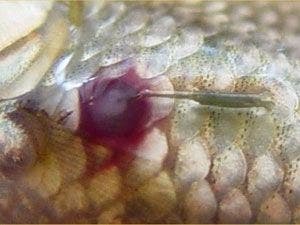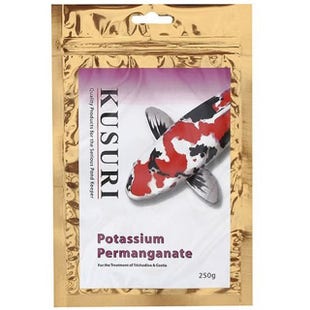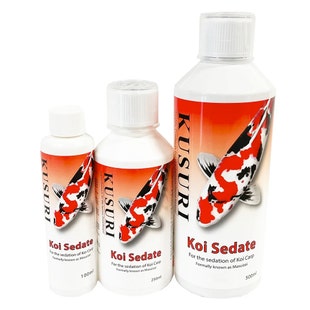Anchor Worm

Lernea (Anchor Worm).
This koi parasite is most commonly found on newly imported koi, and should be dealt with by your koi dealer, it is rarely a problem for the koi hobbyist. It is visible to the naked eye and the adult parasite may reach 12mm in length, with anchor like appendages at the head. It attaches to the koi and the anchor penetrates under the scale and into the muscle of the fish, where it feeds. This parasite reproduces by laying eggs, two egg sacs are produced at the end of the females body, the larvae hatch from these egg sacs and swim freely until they come into contact with a koi, they then commence the cycle again.
Crustacean parasite, Lernaea - Anchor worm is a common parasite on our Koi which is clearly visible to the naked eye. The parasite burrows its head into the Koi's tissue, under a scale and only the body and tail are normally visible.
The juvenile stages settle in the gills of Koi, when they mature they mate and the male leaves the Koi, the fertilized female settles on the body of the Koi and continues to grow, becoming the familiar worm shape.
The female buries into the skin and underlying tissue to hold on. The damage caused can become a target for bacterial or fungal infection which can spread.
Lernaea lay eggs which can lay undetected in the pond and can hatch when conditions and water temperatures are right.
The parasite can cause serious damage to the koi where it penetrates the tissue. These wounds sometimes heal very slowly and if untreated become infected with bacteria and fungus, it is these secondary infections that cause the most risk to the koi.
To treat Anchor Worm you must treat the pond to sterilize the adults, this treatment should be repeated after seven days to ensure any eggs that were unhatched at the first treatment are now sterilized after hatching. Now all reproduction has been stopped. The treatment used is Dimilin.
Now the adults must all be removed from the koi. To do this you will need to sedate each koi individually and carefully remove the parasite with tweezers, making sure you remove the entire thing including the anchor part. Each entry wound should then topically treated. Check every koi in the pond to ensure none are missed.
Treatment is by manual removal of the parasite with tweezers under anesthetic, ensuring that the whole parasite is removed. To be sure of complete removal, dip a cotton bud in strong potassium permanganate solution and dab the worm with this solution whereupon it will release its grip immediately. Pond treatments include Dimilin or Paradex.


